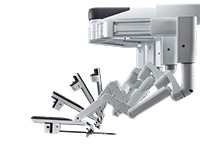 If your doctor has recommended that you have robotic surgery, you're hardly alone. This high-tech procedure is now being used for surgeries as diverse as hysterectomies, hip replacements and heart surgeries.
If your doctor has recommended that you have robotic surgery, you're hardly alone. This high-tech procedure is now being used for surgeries as diverse as hysterectomies, hip replacements and heart surgeries.
But what is it exactly? Or perhaps more pertinently, what is it not, since its name suggests that robots perform the surgery? That's wrong—doctors do. And that is just one important fact to know about robotic surgery. Here are some more.
During robotically assisted surgery, the surgeon sits at a computer station and controls the robot's arms, which have tiny surgical instruments attached to them. A thin tube with a camera attached to one of the instruments allows the surgeon to view a magnified 3D image of the body as the surgery takes place.
The robotic arms match the surgeon's hand motions as the procedure is performed. That means the surgeon is in control.
Robotic surgery is similar to laparoscopic surgery—a way of operating through small incisions. For both procedures, surgeons use a few small cuts, rather than one longer incision that is used during traditional, or open, surgery.
This minimally invasive approach allows:
• Speedier healing.
• Less pain and bleeding.
• Reduced risks of infection.
• Shorter hospital stays.
• Smaller scars.
Once a robotic arm is inserted into the body, it's easier for doctors to use surgical tools than with traditional laparoscopic surgery. The surgeon can also see the surgical site more easily because of the magnified images, potentially improving their precision.
Still, robotic surgery may take longer to perform than standard laparoscopic surgery. The potential for infection, bleeding and a reaction to anesthesia still exists. And in some cases, robotic surgery isn't an option—or it may not be the best choice.
Always talk to your doctor about the risks and benefits of robotically assisted surgeries.
Watson Clinic has long been on the forefront of robotic surgical technologies. For a complete list of our participating doctors and the procedures they perform robotically, visit
WatsonClinic.com/RoboticSurgery.
Sources: Agency for Healthcare Research and Quality; American College of Obstetricians and Gynecologists; U.S. Food and Drug Administration; National Institutes of Health